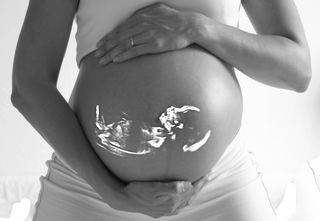Trauma
Perinatal Psychiatry, Birth Trauma & Perinatal PTSD, Part 1
An interview with Dr. Rebecca Moore
Posted August 31, 2016
It is now blatantly clear that a woman’s increased vulnerability to developing PTSD is closely linked to the fact that, when compared to a man, she is much more likely to be the victim of the toxic traumas of childhood sexual abuse, rape, and intimate partner violence. More recently another type of trauma that women are uniquely vulnerable to enduring is garnering increasing attention—the psychological trauma associated with giving birth.

Dr. Rebecca Moore is the lead psychiatrist for the Tower Hamlets Perinatal Mental Health service based in London, U.K. Her clinical interests include PTSD and birth trauma, premenstrual dysphoric disorder (PMDD), the treatment of anxiety and depression in the perinatal period, and supporting the parent infant bond. Dr. Moore is passionate about improving services for women traumatized by birth and hosts an annual forum on Birth Trauma in London in December each year. Her goal is to form networks with those working with families with Birth Trauma around the world to share knowledge and innovative practices.
I recently spoke with her to understand more about Birth Trauma and PTSD.
Dr. Jain: You are a perinatal psychiatrist who specializes in treating psychological aspects of birth trauma. Can you start by talking a little bit about what a perinatal psychiatrist does and why there is a specific need for this type of expertise for pregnant women? Can you comment specifically on your work with immigrant/refugee populations who may have high rates of mental health problems to begin with?
Dr. Moore: Perinatal psychiatrists work with women with new onset or preexisting moderate to severe mental health diagnoses through their pregnancy and up to a year after birth.
We are community based and work with women and their families to support their mental health through this vulnerable time period. This includes regular outpatient review, community nursing support, psychological support, and expertise around prescribing medication during pregnancy and breastfeeding, alongside monitoring the developing parent infant bond.
Perinatal services recognize the fact that for some women, pregnancy is a challenging time period and that certain disorders—Anxiety or Bipolar Disorder, for example—have high rates of relapse.
There is an increased risk of suicide after pregnancy, and suicide remains one of the leading causes of maternal death in the first 42 days after birth in the United Kingdom, as highlighted by the last MBRRACE-UK release “Saving Lives, Improving Mothers’ Care - Surveillance of Maternal Deaths in the UK 2011-13.”
Perinatal disorders often develop rapidly, and our team provides a rapid specialist response to these crises and can facilitate rapid treatment and admission to local Mother and Baby Units if needed. London has three Mother and Baby Units, but many areas of the country still have no provision at all, such as Wales or Northern Ireland.
I work within Tower Hamlets, a very deprived area in East London, with a young population who have higher than average numbers of children. Our population is growing rapidly, it is expected to grow by 26% over the next twenty years, and there is a high birth rate, around 5500 births per year, so the demand on our service grows yearly.
50% of our referrals are Bangladeshi women, which reflects our local population. We have a hugely transient population with people moving in and out of our area, and we have women within our service from all over the world who have often been exposed to war or huge trauma. We often work with interpreters and have to be extremely mindful of the cultural and spiritual aspects of our care.
Dr. Jain: When researching this topic of Birth Trauma, I ran into some issues regarding definitions: there appears to be considerable variability regarding what this term means. Can you offer a definition of Birth Trauma and also comment on how this is different from Postpartum PTSD?
Dr. Moore: You are right, there is not yet any standard diagnostic definition, and this can cause confusion as there is a significant difference between Birth Trauma and Postpartum PTSD regarding symptoms and treatment.
When a woman has a traumatic birth, I mean that there was something subjective about the birth that was traumatic. This does not have to be life threatening or medically traumatic. We are thinking of the psychological impact of that birth experience on the mother.
Birth Trauma definitions include “a negative and disempowering physiological & emotional response to a birth” or “when an individual (mother, father, or other witness) believes the mother’s or her baby’s life was in danger, or that a serious threat to the mother’s or her baby’s physical or emotional integrity existed.” I love Rachel Yehuda’s use of the term trauma as “a watershed event, an event that kind of divides your life into a before and after.”
Common themes include feeling unheard or not listened to, a lack of compassion from medical professionals, and feeling out of control or helpless.
Around 25% of all births in the UK are identified by women as being traumatic. This really strikes me, as it is such a high rate. In fact, if we look at the annual birth rate in the United Kingdom, this means around 173,000 women are traumatized after delivering per year.
Only 1% of births in the UK result in infant death or life threatening near-miss episodes, indicating that subjective understanding of the birth event is crucial.
One third of women present with sub-clinical trauma, and I believe it is essential to perceive trauma responses as being on a continuum.
For many women, these birth experiences will never be discussed or explored. Although women may not develop a diagnosable disorder, they will often experience significant levels of distress and symptoms may persist for many years without treatment. There is often a significant impact on women’s future pregnancies and birth experiences, and I have met women who only have one child because their first birth experience was so negative and they cannot contemplate coping emotionally in another pregnancy.
When we talk about Postpartum PTSD, we are talking about women who had a traumatic birth who then go on to develop all the diagnostic criteria we would expect in PTSD.
Around 1-6% of women who have a traumatic birth will go on to develop a diagnosable clinical episode of PTSD.
It’s also important to mention and think about birth partners who can also be traumatized by birth as well as mothers.
Dr. Jain: In your experience, what are the common pitfalls surrounding diagnosing Postpartum PTSD? How is it distinguished from the more well-known Postpartum Depression? What are the clinical markers for who is more vulnerable to developing Postpartum PTSD, and what are the associated resiliency factors?
Dr. Moore: Unfortunately, this is an issue we see time and time again in clinical practice. Many professionals know little about Birth Trauma or PTSD following birth, and services in the UK are very much focused on identifying Postnatal Depression.
If we think about the criteria needed to make a formal diagnosis of PTSD, there are clear differences in the symptoms needed to make a diagnosis of Postnatal Depression.
With Postpartum Depression we would look for core symptoms of pervasive low mood or anxiety, fatigue, and anhedonia, with possible altered sleep and appetite or suicidality.
In PTSD we would expect to see the key features of avoidance, intrusive memories, labile mood, nightmares, or flashbacks, and taking a history of the birth experience in depth would be key.
Research has been carried out into what makes someone more likely to develop PTSD following childbirth. These risk factors can be thought of as those that exist before the birth; the birth itself; and the type of support and care women get after birth.
Some women will be more vulnerable to a traumatic birth because of pre-existing problems, such as women with a history of psychiatric problems or previous trauma. There is also evidence that women with a history of trauma will be more vulnerable to PTSD following birth if they have inadequate support and care during the birth.
During birth, certain complications or events may be more stressful to women than others. Broadly speaking, women are more likely to get PTSD if they have an emergency cesarean or assisted birth (forceps or ventouse), although PTSD can develop after a vaginal delivery.
Other stressful aspects of birth, such as blood loss, a long labor, a high level of pain, or a large number of interventions, are not conclusively related to getting PTSD.
Women who feel out of control, helpless, or overwhelmed by events during birth, or who have poor care and support from midwives and doctors, are significantly more likely to get PTSD.
Following the birth, support from friends and family, and possibly that from healthcare professionals, may help women resolve their experiences and recover from a traumatic birth.
Studies have also highlighted an increased risk of developing postpartum PTSD with a stillbirth, the birth of a baby with a disability resulting from birth trauma, or a baby requiring a stay in the Neonatal Intensive Care Unit (NICU).
One of the strongest risk factors we know of is when women dissociate during birth. One woman I worked with spoke of dissociating in pregnancy and “losing all track of time” and “feeling like she was in a fog.” She believed her baby “had been born” and “taken out of the room without her consent” and felt overwhelmingly anxious, until suddenly she looked down and saw her pregnant bump and realized she was still pregnant.
The literature regarding resilience is unclear, and we still do not fully understand why some women develop PTSD after birth and some do not. Women come into labor with their own unique genetic make up, personal history, and own expectations of their labor and how it will proceed. To my mind the issue that often makes the most difference regarding the outcome is that psychological expectation and understanding of birth and how it is addressed and handled during labor. I have seen women who had long distressing labors with numerous physical interventions or complications who have not gone on to be traumatized as they have had one amazing healthcare professional with them through the whole process explaining, listening, and comforting them and hearing their fears or wishes voiced.
In my next blog post, I'll share part 2 of my interview with Dr. Moore.
Copyright: Shaili Jain, MD. For more information, please see PLOS Blogs.




